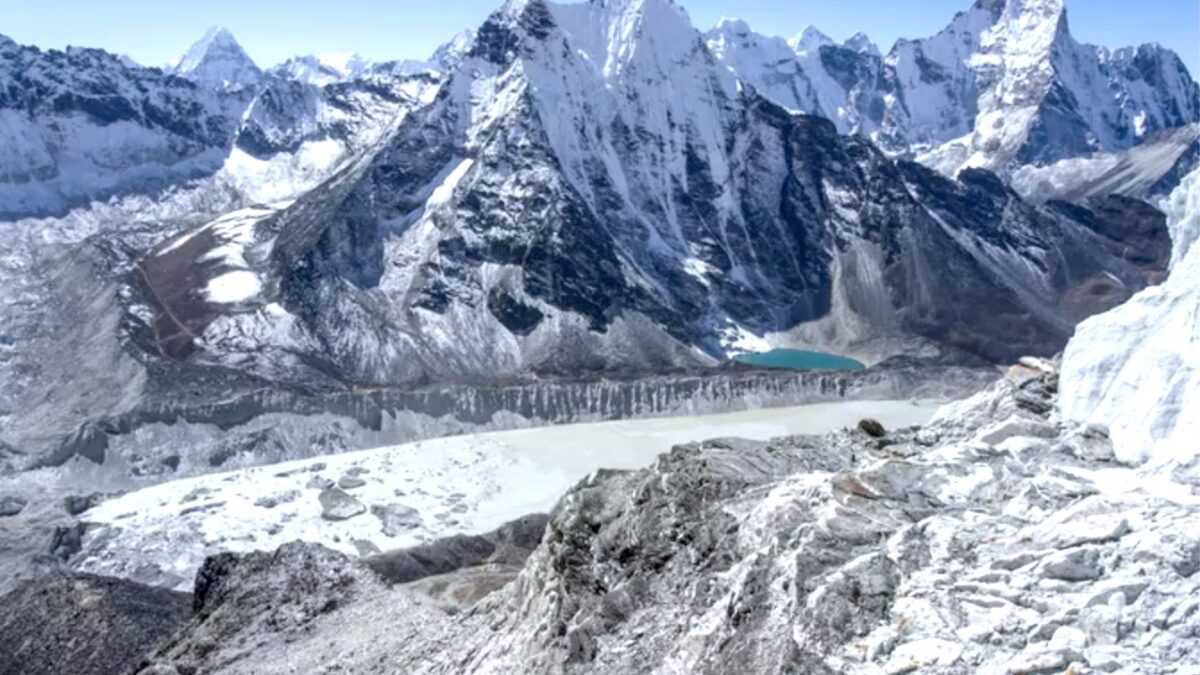
Imja Glacier near Mt Everest has turned into a big lake in the past 20 years. Photo: Kiril Rusev via Nepali Times. Used with permission.
This article was originally published in Nepali Times and an edited version is republished on Global Voices as part of a content-sharing agreement.
Four years after scientists put out a worrying report about the melting Himalayan icecap, they have now warned that the problem is even more serious than earlier thought.
The new study provides what is said to be the most accurate assessment of snow, ice, and permafrost in the Himalayas to date: that Himalayan glaciers could lose up to 80 percent of their ice mass by the end of this century. The findings cite grave consequences, not just for the mountains, but for the nearly 2 billion people living downstream in Asian countries that depend on water from the world’s highest mountains.
The Kathmandu-based International Centre for Integrated Mountain Development ICIMOD had brought out the Hindu Kush Himalaya Assessment in 2019. But the new report says Himalayan glaciers disappeared 65 percent faster in the 2010s than in the previous decades. At that rate, the melting will accelerate in the coming decades.
The Water, Ice, Society, and Ecosystems in the Hindu Kush Himalaya (HI-WISE) report draws on recent scientific advances to map out how melting snow, ice, and permafrost in the mountains will affect water, ecosystems, and society in the Himalayan watershed.
The peer-reviewed study warns of grave consequences to the region that provides fresh water to a quarter of the world's population and is home to four global biodiversity hotspots.
The HI-WISE report projects “peak water” by mid-century after which there will be less and less water available on Himalayan rivers for irrigation, household use, industries and hydropower. At the same time, extreme weather due to climate change will also increase the risk of landslides and floods in this geologically and ecologically fragile mountain region.

The south face of Saipal Himal in western Nepal, showing shrinking ice over the past 15 years. Image via Nepali Times. Used with permission.
“Climate inaction is accelerating,” warns Saleem ul Huq of the International Centre for Climate Change and Development in Bangladesh. “This report shows that the Hindu Kush-Himalaya (HKH) region is particularly vulnerable to the impacts of climate change. We must act now to protect this region and its people.”
The report says the impact of the melting cryosphere on fragile mountain habitats is particularly acute, and it will have cascading impacts on ecosystems and biodiversity.
“With 67 percent of the HKH's eco-regions and 39 percent of the region's four global biodiversity hotspots outside protected areas, the HKH’s extraordinary biodiversity is particularly vulnerable to climate impacts,” the report warns.
Some 240 million people who live in the Himalayas and another 1.65 billion downstream in 16 countries of Asia will be affected by water shortages as the Himalayan icecap melts. Farmers in the Himalayas are already facing crop loss, fodder shortages and livestock deaths due to extreme weather.
“The hazards are becoming more complex and devastating,” says the report that was prepared by 35 scientists from 12 countries.
The report urges policymakers to prepare for the cascading impacts of climate change that provides fresh water to a quarter of the world’s population. It calls for urgent international support and regional cooperation for inevitable, near-term loss and damage, and to help communities adapt.






